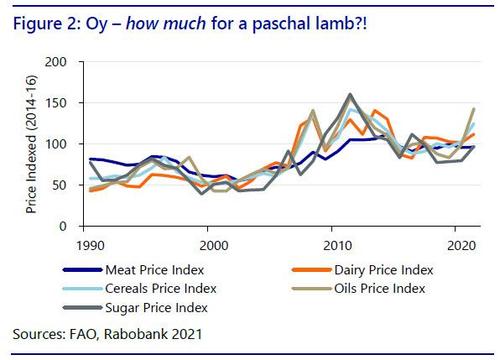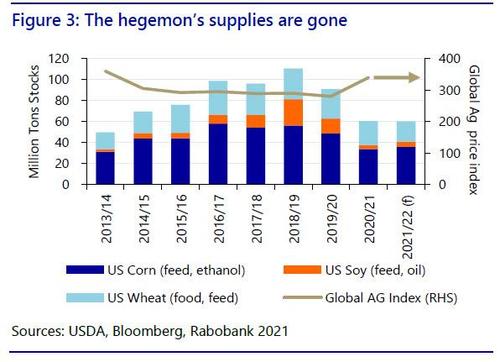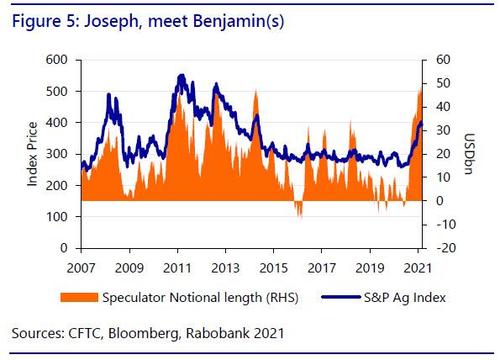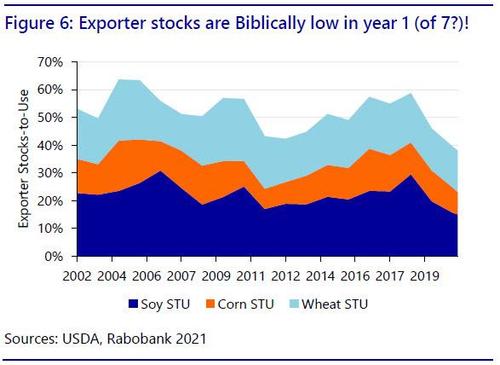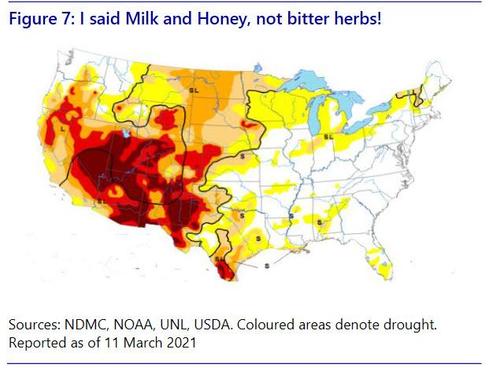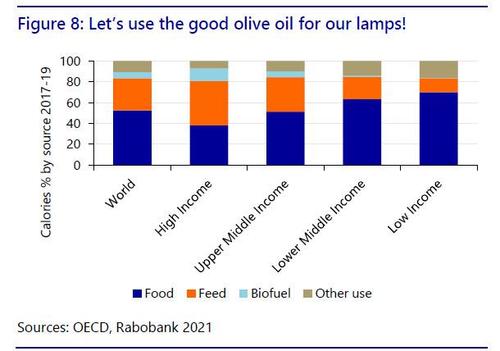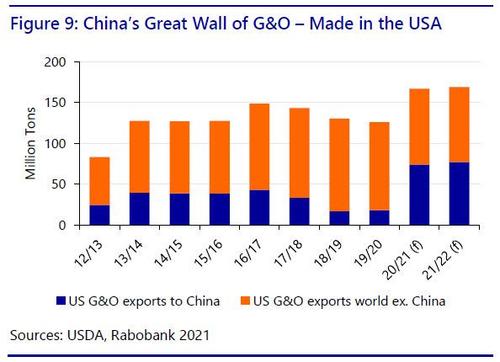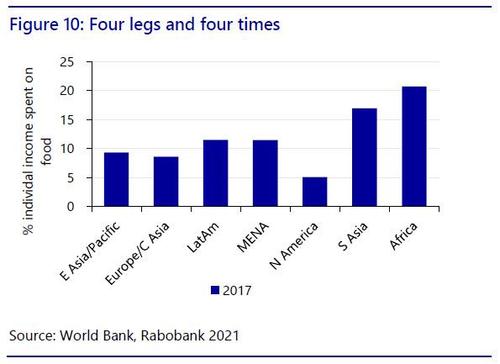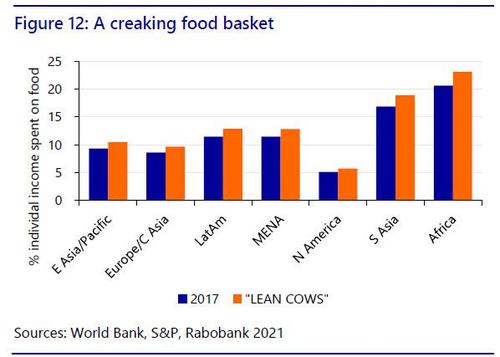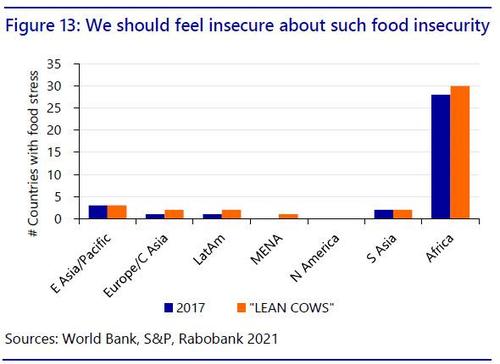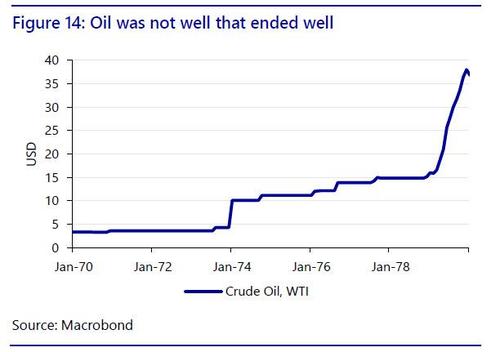By Michael Every of Rabobank
Biblical, Lean, and Mean: 'Dreams' of an agri-commodity super-cycle
Then Pharaoh said to Joseph: “Behold, in my dream I stood on the bank of the river. Suddenly seven cows came up out of the river, fine looking and fat; and they fed in the meadow. Then behold, seven other cows came up after them, poor and very ugly and gaunt, such ugliness as I have never seen in all the land of Egypt. And the gaunt and ugly cows ate up the first seven, the fat cows. When they had eaten them up, no one would have known that they had eaten them, for they were just as ugly as at the beginning. So I awoke.”
- Genesis 41:17-21
Summary
Key feed and food prices have been pulled to 9-month and 7-year highs
We explore the ‘dream’ of Biblical scarcity; its origins and impacts; and draw comparisons with Joseph, the trader and central planner who avoided starvation for ancient Egypt
One point is clear: global food insecurity falls heaviest on lower income, importing nations, who spend a far greater share of their income on food than the richer ones
The Fed would play an ironic role in this process even as it embraces fighting poverty and inequality alongside inflation
This could exacerbate (geo)political risk – potentially even regarding institutional architecture
Our Base Commodity Call
At time of writing, our forecasts for three of the world’s key agri commodities, soybeans, corn, and wheat are as follows:
The First Big Commodity Call
In the Bible, Joseph interpreted Pharaoh’s dream as meaning great abundance for seven years would be followed by an equal famine. He was then entrusted with ensuring Egypt’s storehouses were full of grain so the country could survive – which he, and it, did.
In short, Joseph made the first agri commodity cycle call, where survival came before profits. Today we have seed technology, automated agriculture, and global markets. Yet we still have lean and fat years for reasons meteorological, logistical, political, and geopolitical. This report will try to do several things:
Summarise price action in key agri commodities to consider if we are seeing anything unusual – we will show we are, reflected in our elevated base price forecasts;
Disaggregate and define the main drivers of these price movements. While the agri market is very old, new developments could produce striking new price patterns;
Imagine what a Biblical scarcity would look like, putting forward simplified assumptions to estimate what each of them in isolation could do to food prices;
Look at global food insecurity to ascertain how many countries are suffering already and would do so in the scenario that prices rise higher; and
Consider the worrying (geo)political implications.
1) Supplies Shaken, not Stored
For key feed and food commodities, the message for markets and institutions is a simple one: they are going up. The S&P global agricultural index is up for a 9th straight month, to its highest level in 7 years (see Figure 1). Even though we are coming off a low base of comparison, which helps the base effects, the last period to see such a rapid rise was 2011, and prior to that 2007.
When we look at key commodities one by one the picture is similar, whether it is grains, vegetable oils, dairy, meat, or sugar (see Figure 2). This correlation makes sense, especially as many of these products share characteristics, are complementary, or are planted on the same land.
Most of the above markets have shifted into strong backwardation, indicating near-term supply scarcity that should ease with harvest replenishment. However, we remain sceptical about the resupply.
Rabobank’s price forecasts for soy, corn, and wheat --the critical building blocks for bread, meat, dairy, biofuels, and more-- are in line with present levels and above the futures curve into 2022.
2) A Bull-run of Many Colors
Today’s elevated price trajectories shows nobody had the foresight, fortitude or financial power to stockpile in the years of plenty, but there are many more factors at play. Rabobank’s recent report already covered the key drivers of the agri bull market. We will quickly reprise them as follows:
Exporters stocks have fallen rapidly to 7-year lows;
China is importing on a vast scale;;
It’s hard to increase supply rapidly;
Adverse weather conditions;
Countries are engaging in food protectionism;
Logistical costs are rising, notably in freight; and
Speculators are holding more commodities futures.
#1 Seven years of plenty ironically leave global agri commodity stocks low. Before the recent run-up, the S&P GS Agri Commodities Market Index had fallen over the last seven years as the price shock of 2010-12 incentivized diversified supplies and a shift from high cost to low cost producers/exporters. This was good news for importers, but bad for the high-cost US, who saw its stocks steadily increase through 2019. The US-China trade war and Covid-19 also saw US farmers adjust acreage lower in response.
When demand then surged in mid-2020, higher cost exporters, especially the US, sold both their production and stores. In short, the US --the global food reserve bank-- has seen its grain and oilseed stockpiles slip nearly 30% y/y (see Figure 3), primarily in corn and soybeans. Moreover, we forecast only a slight increase in 2021 as our base case.
#2 China is driving demand. It is aggressively bidding for supplies to fill shortfalls and pad inventories (see Figure 4). Convalescence from dual pandemics --African Swine Fever and Covid-19-- has led to a surge in agri import demand, and hence global prices. The most remarkable increases have been in feed grain, the energy source for animal protein and ethanol: China’s imports of these have risen almost three-fold in a year to address a structural supply gap that cannot be addressed by domestic production. Indeed, China is so stretched for feed it is resorting to using old domestic wheat reserves for livestock -- 35m metric tonnes this year alone, equivalent to Canada’s production-- in addition to vegetable oil, and even pig lard.
China’s moves are singlehandedly testing supply chains to their limits. The saving grace for global markets has been that world demand across many of China’s favoured imports was absent or squeezed until now; when it returns, global supplies could be stretched further.
#3 Supplies are on a tight-rope. Coming months will see a scramble by farmers to plant and harvest. With many products facing scarcity, competition for limited arable land will limit the potential resupply. The US, for example, can only increase its summer plantings by about 5%; any production on top needs to come from yield improvement.
#4 Everything depends on the weather, where key exporters face an uphill battle. Large swathes of South America are too dry or too wet; meanwhile, much of the spring planting area in the US faces significant dryness.
#5 There is a heightened risk of protectionist policies. Many critical agri exporters are already putting up tariffs or export quotas, threatening free trade and curtailing local farm prices and domestic production to keep prices affordable. Rather than fulfilling their critical global role, such exporters are increasingly insulating themselves from global markets: Russia, the world’s largest exporter of wheat, has implemented grain export taxes; Ukraine export quotas; and Argentina, the largest exporter of protein feed, has dabbled in export quotas too.
#6 Logistics are tight. If a rising tide lifts all boats, a lack of boats lifts prices. ASF, Covid, and weather events all drive demand shifts that suppliers have been unable to anticipate or react to easily. Freight prices have jumped to a record for containers: bulk (measured by the Baltic Dry Index) has also seen large increase, and this has delayed and displaced shipments: naturally, these higher prices fall heavily on importers.
#7 Speculators. Wall Street funds already hold in-the-money positions in soy and corn – by far their largest net long position. Financial market investors currently hold contracts of grains, oilseeds and livestock worth almost 50bn USD net length or 35% of the value of all US agricultural exports in 2020. (see Figure 5.)
What makes this significant, apart from the scale, is that this is happening due to the actions of central banks. While Joseph was second only to Pharaoh, so central banks are second only to governments: yet they are not helping to smooth out food cycles like Joseph did.
Markets have grown used to extreme monetary policy since 2008. However, the aggressiveness of the Fed’s current policy stance, now aimed to let the economy “run hot”, and the shift to massively expansionary US fiscal policy too, has altered market perceptions of future inflation risks. Investors have responded by holding assets as a hedge: stocks, property, and gold/ Bitcoin.
Yet Wall Street is now holding/speculating with agri commodities too - even though this pushes up inflation!
3) A Biblical rally
Having then listed the various structural reasons for agri commodity prices to have risen so fast, we free our minds to ‘dream’ (if that is the right word) of a Biblical price rally. Our bull market stands on four legs:
(i) Normal supply and demand (which is how day-to-day markets are supposed to work);
(ii) China (given its import appetite makes it the marginal buyer that matters most);
(iii) Politics (covering changes to trade flows, protectionism/tariffs, and export controls); and
(iv) ‘Wall Street’ (where could equally say ‘the Fed’)
Leg one: Normal supply and demand:
As noted, the FAO price index at 7-year highs is supported by rises in all of its components; sugar, cereals, meat, oils and dairy. In our dream we ruminate on the products who’ve risen the most, and are thus closest to scarcity: cereals and oilseeds. They are currently so tightly balanced a small weather issue --a regular occurrence in agricultural markets-- could tip the scales towards global scarcity.
The USDA, today’s high priests of agriculture, expect maximum acreage and healthy yields in the US to maintain, but not reflate, stocks. Yet they are arguably dreaming! The US has seen two consecutive disappointing summer crops (feed grains: 359 and 375 million metric tons, soy: 93 and 113 million metric tons); and yields can often worsen, rather than improve, on expanded --less ideal-- acreage. Imagine a third consecutive lacklustre US summer harvest.
Even if last year’s average, not poor, yields were repeated in corn or soy, supplies would fall below 2012 levels, a time prices were 35% higher than today. All else equal, even a 3-4% drop in production could move soy and corn prices up by a third.
In normal times, alternative grain and oilseed export surpluses might help cushion the blow of a US supply shock – but if we take these into account too, cumulative exporter stocks-to-use are still close to 2012 levels (see Figure 6).
We started with soy and corn: but feed grains and oilseeds compete for acreage with other commodities. Moreover, soy and corn are the primary feed components for both animal protein and dairy, and produce cooking oil and biofuels.
Wheat, for one example, exhibits slow demand growth in line with slowing global population growth, but also little elasticity. The upside is that there are so many substantive exporters, which distributes supply risk. Yet global exporter stocks are again already near 2012 lows: a 10% production cut in major suppliers like the EU, US, or Russia could lift prices 30% to levels last seen in 2012.
Can this Pharaoh’s dream be interpreted to see any one commodity evading inflationary capture? Current futures market positioning may be too somnolent.
As noted, adverse weather is already affecting major production areas. Over 90% of the US Northern Plains (the area most likely to boost overall acreage), 50% of the Midwest, and 59% of the South are already in some form of drought (see Figure 7).
With winter wheat emerging, and soy, corn, and cotton about to be planted, the terrain looks nothing like the promised land the USDA is projecting. Perhaps they shouldn’t have slept on the National Oceanographic and Atmospheric Association report predicting three months of dry, warm US conditions ahead.
And what if we were to get a real US drought, as in ancient Egypt? Obviously this would be far, far worse on all fronts.
Leg two: Politics
Any crisis in food inflation risks being exacerbated by food politics. Emergent food export heavyweights like Argentina, Ukraine, and Russia have played a role in driving prices higher through export taxes and controls; and trade wars have been destabilizing and inefficient for agri flows.
In short, global supply chains appear bereft of the underlying geopolitical stability assured until recently.
In the case of a future supply issue, however modest, there is a risk of heavier exports controls. For one key hypothetical example, if Russia re-implemented its ban of 10 years ago on even half its export potential – 19m tons, the ensuing burden on the US and others could double wheat prices to the USD12/bushel last seen back in 2008.
A further ‘political’ catalyst is biofuels, beneficial for farmers and the environment, but which exacerbate agri commodity supply stresses by shifting production from food towards renewable energies made from agri commodities: namely biodiesel and ethanol. Figure 8 shows higher income nations employing over 12% of their caloric inputs (primarily vegetable oil and feed grains) for biofuel ingredients.
The ethanol market was largely absent last year amid a surge in feed demand; its return could exacerbate supply pressures. For the US, a 500 million bushel rise in ethanol usage fully offsets potential acreage expansion in 2021, for example. Assuming a doubling of ethanol exports (to China), it would not be unrealistic to assume corn prices could potentially rise a further 15%. Full implementation of biodiesel and renewable diesel mandates in Indonesia, Europe, Brazil and others, supported by high diesel prices, would potentially drive support for key component vegetable oils like palm and soy near or to record levels.
In short, in the short term --where politics happens-- the Green transition could mean higher food prices.
Leg three: China
China is the single biggest swing factor besides weather/production. It has the potential to disrupt global agri balance sheets for years to come.
In the past, China has implemented Joseph-like policies and holds large stockpiles of wheat and rice, However, amid elevated domestic prices and imports of dairy, pork, oils, and grains, it is far from apparent that China is purely engaging in strategic “restocking”: rather in our ‘dream’ we interpret that China is rapidly destocking in products including feed grains and oilseeds.
Higher imports and domestic production increases are the apparent solution. China is expected to import 35-45 million metric tonnes of feed grains per year for the coming years - much more if rosy production expectations are unfulfilled. If China’s domestic output disappoints, it would exacerbate a structural deficit requiring yet higher imports of grains and oilseeds --by as much as 15m metric tonnes-- and raise global prices of corn and soy by additional 30%.
Leg four: Wall Street
As already noted, Wall Street is an established player in the agri commodity space and has room to grow its inflation-hedging bets from here. Despite current long positions, the overall net position is still nearly 10% below the record.
Wall Street probably wouldn’t increase its positions in a vacuum: but if any of the above ‘legs’ come to pass, it would likely respond. Funds could easily extend their speculative length, not just in feed, but also wheat. This ‘dream’ could help push agri prices up to the 2012 peak 40% higher from here.
Moreover, should US ultra-loose monetary and fiscal policy produce significant US inflation, or stagflation, and/or yield curve control to peg the long-term cost of borrowing, Wall Street would again likely increase its agri commodity inflation hedges.
We summarize the relative impact on soy, corn, and wheat in this (bad) dream scenario below:
For soy, the primary price driver ahead is weather (5 from a maximum 7), then China and Wall Street equally (3), then potential political actions (2). For corn, China is the largest potential factor (5), followed by weather (4), then Wall Street (3) and politics (2). For wheat, weather (3), politics (3), and China (3) are all equally important, with Wall Street relatively less so (2).
Of course, all cows stand on four legs, and any one of the factors above could play out individually for any one commodity to significant effect. Yet as with any cow, where one leg goes, the others usually follow.
In short, if we were to see bad weather; and protectionism/sustainability-related regulations; and further heavy buying from China; and a surge in Wall Street speculation then it is hard to say just how high prices could reach before demand destruction kicked in.
(4) Food Security
The impact on food security should be obvious: indeed, it already is:
In the MENA countries --the highest per capita consumers of bread-- the 30% increase in international wheat prices seen so far in 2021 leaves them just shy of levels seen during the revolutionary Arab Spring;
Asia’s burgeoning middle class is grappling with 30-50% increases in pork, cooking oil, sugar, and dairy prices; and
Africa, with lower GDP per capita, has an even clearer predicament.
Yet in our dream, things get worse. The impact of price increases will fall disproportionately on poorer, importing countries, reversing the improved economic outlook for some of the new global middle class - and even lower income deciles in the wealthiest countries would feel it. We attempted to summarise these risks with simple snapshots.
World Bank data from 2017 show USD income per capita around the world at purchasing power parity. The same data also show the amount spent on food per capita. One can then calculate the percentage of income allocated to food (see Figure 10). Obviously, the figures vary between wealthy regions, such as North America, and poorer ones, like Africa, where the differential is over a factor of four.
Holding income figures constant (as this is just an indicative exercise), we then change agri commodity inflation. Although such agri price changes have and will vary by commodity, we use the aggregate index as a base to avoid having to break down the complexities of varying national diet patterns.
As we showed, since 2017, agri commodity inflation has been substantial (45%). We then project a hypothetical doubling of the agri commodity basket for our ‘lean cows’ dream on top.
We must then consider how much of the change in price in the agri commodity basket is actually passed on to higher food prices. One might be surprised how little of the cost of the foods we eat actually reflects the raw ingredients as opposed to labour, rent, logistics, etc. (See Figure 11.)
Keeping all of these factors unchanged, we presume that agri commodity inflation of around 100% would translate into recorded global food price inflation of around 12%. This reflects OECD food inflation of 6-8% in recent scarcity events, while recognizing that in some sectors and markets this has tended to be higher, in particular for import dependent countries.
As can be seen in Figure 12, on a regional basis we can see that for East Asia and the Pacific, the percentage of individual incomes spent on food rises from 9.3% to 10.4%; in Europe and central Asia from 8.6% to 9.6%, Latin America from 11.5% to 12.9%; the Middle East the same 11.5% to 12.9%; North America 5.1% to 5.7%; South Asia from 16.9% to 19.0%; and sub-Saharan Africa from 20.7% to 23.2%.
Of course, the actual impact may be less given incomes would have risen in most places in the past four years in line with GDP growth – but then again Covid-19 could well have seen these gains partially reversed in many locations.
To put this into perspective, one also needs to consider where a crisis threshold lies in terms of food affordability.
Although this again varies for a number of reasons, if one selects the 20% of income as the key level, double the world average, then the global impact of this ‘dream’ agri commodity price shift cannot be understated.
Figure 13 shows the total number of countries in each region that were already at risk of food insecurity using the World Bank’s 2017 data compared to the number projected ahead using our “lean cows” assumption. As can be seen, Central Asia sees 1 additional country slip into food scarcity; Latin America 1; MENA 1; and Africa 2. Again, this is presuming a 12% increase in food prices: if more lean cows were to emerge, more people would also get leaner.
Even as is, 42 countries globally would be food insecure: and a staggering 102 countries would see a relative decline in their purchasing power of food, representing a step backwards down the pyramid – Maslow’s pyramid of basic needs. We would be back below 2011 levels in terms of food affordability, representing over a lost decade in the fight against hunger.
At the very least, steady progress experienced by much of the emerging world’s middle class could be frozen or reversed. That’s a process we have seen end in populism in Western economies already.
‘Yum’ Kippur?
We are talking here about a potential surge in parts of the agri-commodity complex. However, our global macro inflation thesis remains very different.
We continue to recognise the significant near-term upwards price pressures in many areas of the economy, which stem from a combination of base effects, Covid-related supply disruptions, genuine demand increases - or shifts, and looming US fiscal stimulus. Yet as we have argued for many years, structurally one only sees inflation sustained if either supply is too weak (and outside agri commodities and semiconductors, this is not an issue), or demand too strong – and workers still do not have the bargaining power to push for pay rises in most sectors of most economies. The present US fiscal stimulus does not address this issue at all.
Indeed, the greater likelihood is still that after an upwards surge in H1 2021, there will be a downshift in aggregate inflation pressures again into 2022. Were we to see a bounce in the US dollar on the back of higher long end US rates, this would exacerbate that trend: it could also partially weigh against some of the bullish agri-commodity trends we consider.
Moreover, were we to see an economic slump after the current US fiscal ‘sugar rush’, then presumably agri commodity prices would come under further downward pressure: note that previous spikes have often been rapidly followed by just such a slump. (More like seven lean then seven fat months in that case!) In that case, the Wall Street speculation we have already underlined would also be rapidly reversed: and what has helped make for fat markets would then make for lean ones. In short, volatility would be amplified in both directions.
Nonetheless, let’s dream agri commodity prices stay high for structural/political factors even as aggregate inflation falls back due to a weak global economy. We have seen something similar to this hypothetical backdrop previously if one shifts the kind of oil one is thinking of.
Indeed, think of the oil price spike experienced after the Yom Kippur War of 1973 and Arab oil producers responding with reduced supply into what was then a far more Keynesian, fiscally-driven world economy.
WTI oil, for example, jumped from USD3.56 in July 1973 to USD4.31 at the end of that year --a 21% increase-- and then again to UDS10.11 --a 293% increase from the July 1973 price-- at the start of 1974 in response to Arab oil-state’s actions (see Figure 13). This necessarily pushed general inflation much higher in tandem globally.
As we know, the demand-led policies of Western economies, which were still far more regulated, far less globalised, and had far stronger unions at that time, led to inflation-matching pay rises, so setting off a wage-price spiral. Consequently, oil prices marched as high as USD39.50 --a 390% increase over January 1974 and 1,109% over July 1973-- before eventually declining.
What is critical to recall is that this episode was arguably the key political driver of the structural reforms put in place to globalise and liberalise Western economies in order reduce the power of labour in favour of capital, capping inflation pressures in the process. With global populism rising, and critics pointing out those reforms have gone too far, producing socio-economic problems of an entirely different but just as damaging kind, the key hypothetical to ponder is this:
Could a sustained rise in agri-commodity prices prompt a political backlash away from neoliberalism and back towards deglobalisation and regulation? Could the Yom Kippur-driven reforms be reversed by a ‘Yum’ Kippur?
Of course, nobody knows. However, you don’t have to be Joseph to see that political developments such as Brexit, and obvious examples of agri protectionism, mean it would be dangerously naïve to rule this risk out entirely.
This in itself would then open up a new discussion of what such a structural shift might mean for the increasingly-turbulent geopolitical backdrop, and how that then might flow back to markets.
After all, there was open talked of an Arab “oil weapon” after the 1970s: and the emergence of the “Petro-dollar” was intimately linked to how the huge oil surpluses Arab states then began to accumulate were recycled: in short, into the US, in exchange for US military protection.
This brings us firmly to geopolitics.
And Pharaoh said to Joseph, “See, I have set you over all the land of Egypt.”
5) Not Just Any Dream Will Do
After all, let’s not forget that Egypt was the ancient world’s superpower because of its grain harvests: the flow-through from food prices to geopolitics today should be obvious:
First, weaker states could find themselves at risk of significant instability: it’s not a coincidence the last global agri commodity price surge coincided with the Arab Spring. Given even developed economies have experienced major socio-political unrest, the risks should be self-evident. In short, an agri commodity price spike, like Covid-19, could be an accelerant to pre-existing political trends.
Second, we live in a new age of Great Power politics, centred around an unfolding US-China rivalry, in which US food production and a Chinese food deficit plays no small part. Would higher agri prices mean the US-China Phase One Trade Deal holds, or breaks, for example?
More broadly, a key question is whether an agri commodity price shift higher would help force changes in the structure of the global economy and financial system. We have covered the likelihood of a paradigm shift away from the USD many times, and have always been highly sceptical. Yet hunger is a powerful incentive for action.
Such a ‘lean’ backdrop could accelerate efforts to shift the global trading system away from the USD. Both China and Europe could push for adoption of alternative payments systems, or at the very least for commodity pricing in EUR or CNY.
China is already trying to boost local agri production and diversify its agri imports. However, it would require an entire network of major agri producing countries to make a FX/trading paradigm shift away from the USD in tandem with it in order to break free from the US(D) yoke in agri markets. Until then China would remain in a relatively weaker position vis-à-vis the US on this key front. Its huge appetite for agri commodities (and by extension, USD) would remain: and if it were to continue to snap up global agri supplies, then resentment could rise against it too along with said prices.
On one hand, this suggests a weaker CNY, as we saw under previous periods of structural stress (over exports to the US, and technology controls): on the other hand, a stronger CNY would help make agri imports cheaper. In short, China would have difficult strategic choices to make, with each option coming with major trade-offs.
Europe would be better placed in terms of food security due to its comfortable agri surplus and high incomes. It also has plans to broaden the international usage of EUR. Yet its twin Achilles’ Heels are still that relies on a US-controlled Eurodollar and a US-owned defence umbrella.
Emergent global middle powers would have to adapt to a multipolar, volatile geopolitical environment, and ponder what food (in)security means for their own strategic positioning: for exporters and importers it obviously implies very different opportunities/risks. More concretely, would they side with the US or China if forced to make a choice in the global trade/FX paradigm?
Meanwhile, there would likely be a new “Race for Africa”. China has been extremely active there in recent years; so has Russia; and Turkey; and the EU sees itself as having a major role in both Africa and the Middle East. America is also likely to be involved, albeit under the guise of national security – which in a way it of course is.
Ultimately, however, just as the gold-pegged USD segued to a new, bigger fiat role as the “Petro-dollar”, backed by US military might, so the stronger global “Eurodollar” would be supported by the US being a major net food producer and exporter (and military power). Indeed, global food insecurity would underline the extent to which the US can ride out food price cycles that batter other economies, supporting its hegemon status.
For countries unable to afford food imports priced in USD, the US would be in the position to bail them out with FX swaps or loans as it saw geopolitically advantageous – or to support multilateral organisations doing the same. It might not be able to produce extra food at short notice, but it could produce the USD to buy existing food, even if it forced prices to spiral even higher in the process.
Yet at the same time, however, global resentment of the US would likely rise if these actions did not materialise; and/or on the perception that the old adage of “the dollar is our money and your problem” were the US starting point. How much global patience would there be for the Fed (and US government) to echo Dr. Martin Luther King, Jr.’s “I have a dream” on equality if the global outcome was greater food insecurity? How does one sell helping the poorest in one of the world’s richest economies if it also hurts the poor in the world’s poorest economies?
In short, it is the stuff of (bad) dreams: but high global food prices would deepen and widen pre-exiting geopolitical fault lines, and open up new ones. This could easily flow back to agri commodity markets in a reflexive process.
What Dreams May Come
Although nobody’s dreams correctly tell the future, there appears a worrying risk that many individual factors (weather, politics, China, and Wall Street) could individually --and in a worst case, collectively-- push up global agri commodity prices significantly on top of the marked increase that we have already seen in 2021 to date.
Were this to prove the case, food insecurity would obviously increase, with the impact potentially felt by billions, most so in sub-Saharan Africa and South Asia: we would face a potential lost decade for reducing food insecurity and improvements in disposable income; and the rapid growth of their middle classes could be stunted for years. In terms of food affordability, 42 countries would be worryingly insecure, and 102 would be worse off than they were in 2011.
Critically, this would not be something the current global political economy would passively accept. Shortages of luxuries or electronics are one thing: food is quite another. Rising populism among a weakened middle class in the West, 2020’s scramble for PPE, and 2021’s dash for vaccines already all show just how easily the rules of the global trading order can be up-ended when local politics dictates.
All of this would only exacerbate geopolitical tensions that are already evident across various locations.
Moreover it could, in some scenarios, such as last seen in the 1970s, shift our global political economy and financial architecture in new (or rather, old) directions: at least it may see attempts at such, even if not successful.
Food for thought (Joseph), as we consider how Pharaoh this rally still has to run.


